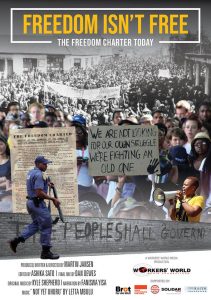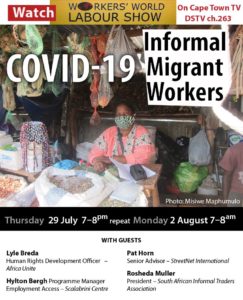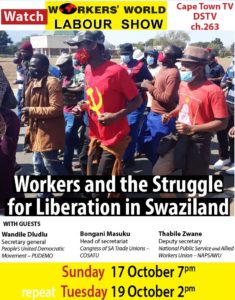By Carilee Osborne
First published in Amandla magazine
In the year of the 100th anniversary of Nelson Mandela’s birth, Martin Jansen’s Freedom isn’t Free: The Freedom Charter Today couldn’t be more relevant. It comes at a time when many South Africans are questioning not only the legacy of their famous founding father and the party that he represented, but also that of the transition more broadly. Despite this, Mandela is barely present in the film. Jansen chooses rather to focus on a diverse range of voices to tell the history and contemporary resonance of the Freedom Charter.
This choice is an important one as it sets the tone for a film that refrains from making simplistic assertions or populist diagnoses about the post-apartheid condition. It is also important in showing multiple angles to the anti-apartheid struggle and its continuities and discontinuities into post-apartheid.
The film begins with a brief history around the creation of the Charter. This is a process that has held almost mythic status in South African history, as much for its inclusive and democratic nature as for the Treason Trial which followed it. This story is enriched by the voices of those who were members of the Congress of the People and present at that momentous occasion in Kliptown in 1955.
Interposed with this history is the question of its adoption during the transition, a process shown to be fraught especially within South Africa’s most prominent labour federation Cosatu., The disputes between the “Workerists” and “Charterists” over the socialist nature of the Charter and the question of a two-stage revolution are not often talked about. But they seem almost prescient given contemporary debates around the legitimacy of the alliance with the ANC and the fractures within Cosatu. South Africa undoubtedly needs more media that deals with histories that exist outside of the mainstream narrative of the “miracle nation”.
The film is arranged around key clauses in the Charter, with excellent use of both archival and current footage, along with original interviews. While a few prominent activists and government officials are interviewed, the focus is squarely on the voices of local activists, especially women. At a screening in Cape Town, Jansen noted his desire to move away from dominant narratives focused on “the big men of history”. This is a most welcome and enriching approach given that the issues that are focused on are some of the most pressing in contemporary South Africa.
Haunting images of education
The first focuses on education, with ample footage from the Fees Must Fall campaigns across the country as well as devastating coverage of the crisis in basic education, especially in the Eastern Cape. The filmmaker makes apt use of contrasting the aspirations of the liberation movements with current realities. One of the most chilling involves speeches by BJ Vorster in response to the Soweto Uprising along with those of then Minister of Higher Education Blade Nzimande in response to the 2015/2016 student protests. Notable in this segment is also footage of a young Nkosazana Dlamini-Zuma speaking about the student protests against Bantu Education in the 1970s.
The continuation of a two-tiered educational system that condemns many into poverty is told through haunting images and interviews with education activists, notably from Equal Education. While not explicitly made, the interplay between basic and higher education is apparent from the way in which the film portrays the two. This is something which has often been missing from mainstream coverage of the 2015/2016 student protests.
Inequality and South Africa’s elite
The Marikana Massacre is, unsurprisingly, a notable part of the film. The horror and shame of that incident is emphasised by a brief focus on the migrant labour system which formed the backbone of the country’s economy for decades. A discussion of the shift to the neoliberal Gear policy in 1996 emphasises the inability of the governing elite to fundamentally alter the structure of the economy despite the end of apartheid. It is here that the figure of Cyril Ramaphosa, now South African president, is most poignant. Footage shows him shifting from union leader emphatically criticising the “bourgeoisie” to skilled negotiator at the transition and eventually to ANC leader.
All of this is underscored by his position on the list of richest South Africans, which is presented in the film. This list is used to show the immense inequalities in the country, and the obscene wealth built primarily on the backs of poor black workers. However, it is also used to show the limitations of discourses around white monopoly capital in a country which has allowed for some transformation of the capitalist class through the creation of a black elite; a manifestation at the heart of questioning the legacy of the Charter.
Land, security and comfort
One of the most well-known clauses of the Freedom Charter has to be “The Land Shall be Shared Among Those Who Work It!” and the question of land redistribution is another focus of the film. Again, a brief history of land dispossession starts off the discussion, which quickly focuses on how little has changed since 1994.
The initial focus is on rural areas and farming, which is often how discussions around land are framed in popular discourse in the country. Importantly however, urban land is also a primary focus, with the limitations of housing provision emphasised. This is especially the case in the context of the shift from RDP to Gear and the limitations of relying on “the market” to meet social needs. As with the rest of the film, activist positions are prominent in these discussions. A number of representatives and footage from myriad civil society organisations paint a complex picture of competing perspectives on how things can or should change.
Linked to the question of land and housing is that of security and comfort, something that remains a dream for a vast majority of people living within the country’s border. While the racial tensions over access to limited resources are hinted at, the portrayal of the horrors of xenophobic violence are also present to remind us that questions of belonging remain complex and in dispute in some communities.
It is fitting that the filmmaker intends to distribute the film to civil society and activist groups. Interestingly, alongside the full-length version, there will also be shorter, issue-focused productions. These will allow organisations to host workshops and screenings using footage focused on their particular struggle, be it housing, education or land reform.
Overall, the film tells itself. There is little narration and the filmmaker largely allows the stories and images to speak. Whilst the ANC is most certainty at the forefront of the film, this is done in a way that allows for some of the complexity of complicity to come through.
The film is a continual juxtaposition between the aspirational nature of the Freedom Charter and the reality of inequality, poverty and violence that define post-apartheid life: Human Settlements Minister, Lindiwe Sisulu, in her plush Cape Town home with crumbling RDP houses and flooded shacks; President and billionaire Ramaphosa with union leader Ramaphosa; thriving private and former Model C schools with crumbling and overcrowded rural and township schools. It is also a story about the continuities of struggle, and whilst it tells many stories, it is not ambivalent about its message. It serves as a damning and necessary condemnation of the post-apartheid project.
Carilee Osborne is a Researcher at Institute for African Alternatives.


